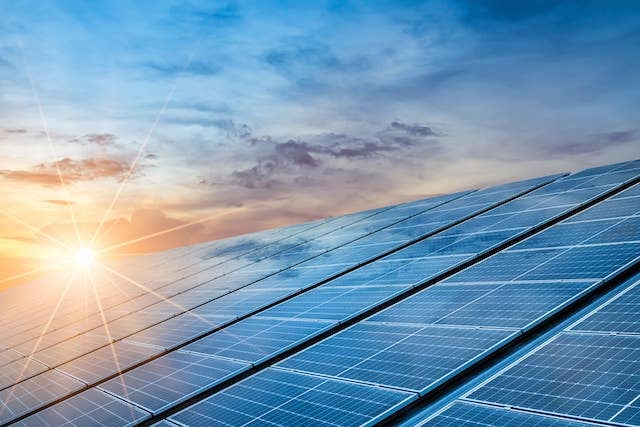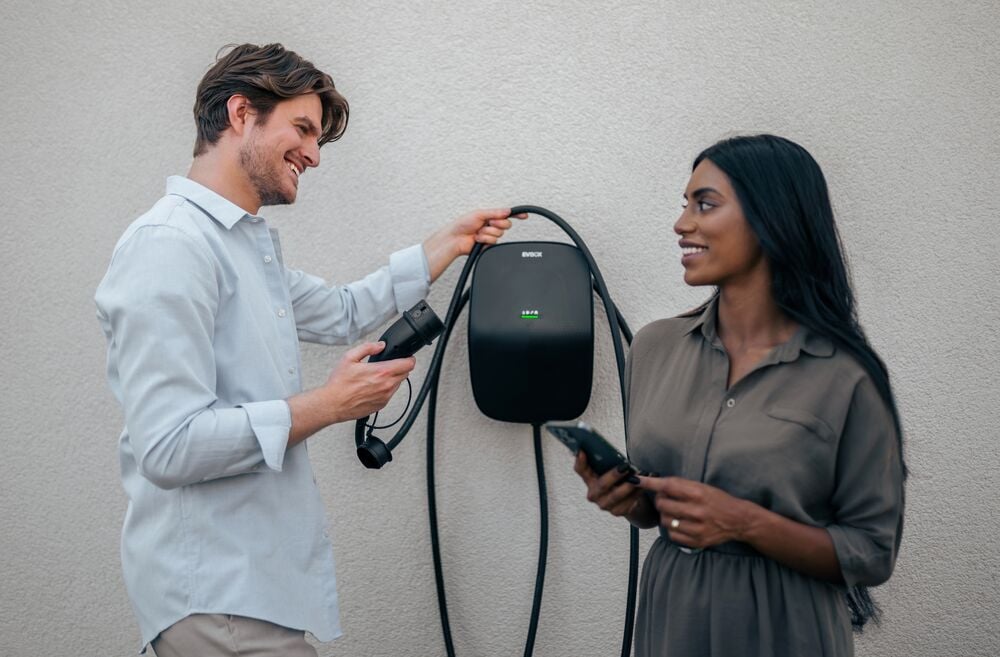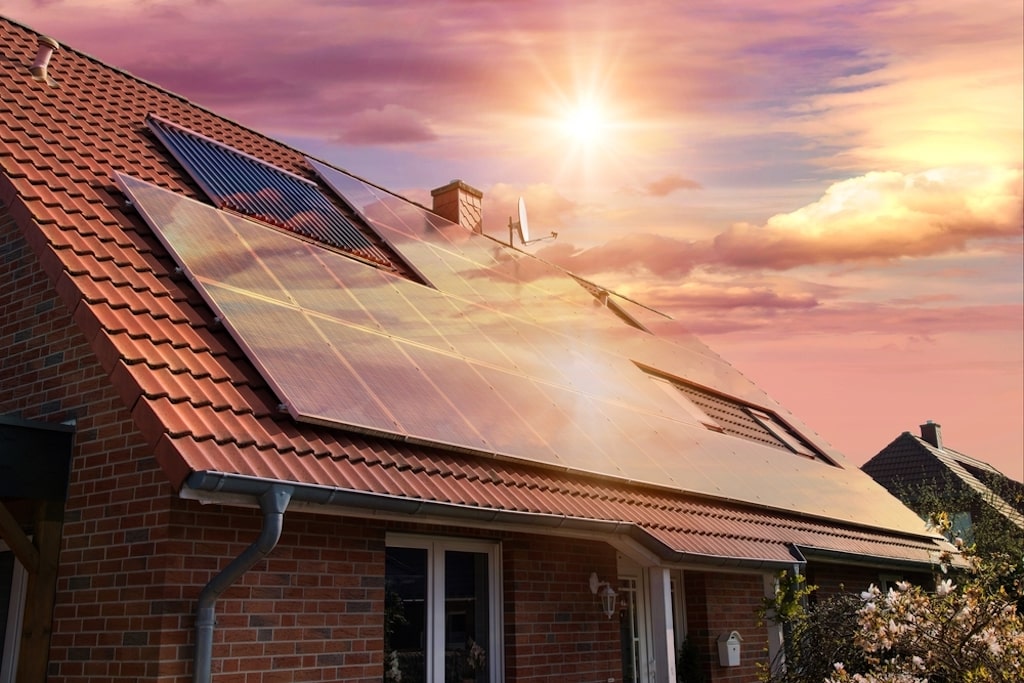
The short and simple answer is: Yes, you can absolutely charge an electric car battery with solar power.
For those who already have solar panels installed, consider this perspective: You're already harnessing the sun's power to charge your phones and devices and to run appliances like your fridge and television. Plugging in your EV is akin to charging one additional device with the electricity your panels produce.
Truthfully though, a standard home solar installation is unlikely to generate enough power in a day to recharge your EV’s battery from 0% to 100%, but considering the average daily driving distances this doesn’t have to be a dealbreaker.
In its most basic setup, your solar panels are connected to your electrical circuit and if you charge your car while the sun is shining, you’re using solar. However, if other appliances are using electricity at that same time, how can you optimize your self-generated solar power for your electric car?
In a nutshell, EV solar charging can be optimized by connecting it to a home energy management system, or via dedicated smart charging features.
In this article we want to help you get familiar with the concept of using solar energy to charge your electric car battery. We'll discuss whether it's feasible to charge your electric vehicle at home using solar energy and examine other factors influencing the viability of such a setup.
Table of contents
- The current state of solar energy
- What is solar energy?
- How do home solar panels work with EV charging?
- Do I need a solar charger if I want to charge my car with solar power?
- How does solar battery storage work?
- What is net metering?
- What about Bi-directional charging?
- Leveraging government and non-governmental incentives for solar EV charging
- What is the future of solar energy?
Solar charging: A bright future
Our world’s dependence on fossil fuels has been increasingly challenged in recent years from an environmental perspective and by both supply and geopolitical issues. To combat these, many countries are seeking to reduce their fossil fuel use, including in transportation sectors, where electric mobility is quickly becoming the new norm.
Global electric vehicle (EV) sales have skyrocketed over the past decade and are not out of rocket fuel yet. While it previously took five years, from 2012-2017, for EV sales to grow from 100,000 per year to 1 million, in 2023 over 1 million EVs were sold in the month of July alone.
This remarkable growth in electric mobility helps replace the use of at least 1.5 million barrels of oil per day, but in doing so it also greatly increases EV users’ demand for electricity.
Given the environmental objectives of a global transition to EVs, the challenge has become to generate enough electricity sustainably to power our EVs with 100% renewable energy. Did you know we already produce around 1/3 of our electricity from renewable sources like solar, wind, and hydro? An equation in which solar accounts for 60%.
The current state of global solar generation
It’s easy to understand the appeal of solar power. Unlike fossil fuels, it is available anywhere in the world in enormous quantities and is completely free to use. It is perhaps no surprise then that global solar capacity has now surpassed wind power for the first time in history and is on track to beat both coal and gas as the world’s biggest generator of electricity by 2027.
According to the COP28 report, Tripling renewables doubling efficiency, the installed capacity of global solar capacity (the total amount of electricity produced by solar alone) reached 1 TW in 2022 and is expected to rise to more than 5,4 TW by 2030. For context, that’s enough to cover the current annual electricity consumption of the USA, Russia, and Brazil combined.
The explosive increase in installed solar power capacity is in no small part driven by individuals and households installing small-scale solar panels on their roofs to become more independent from the grid, cutting their energy costs, and reducing their carbon footprints.
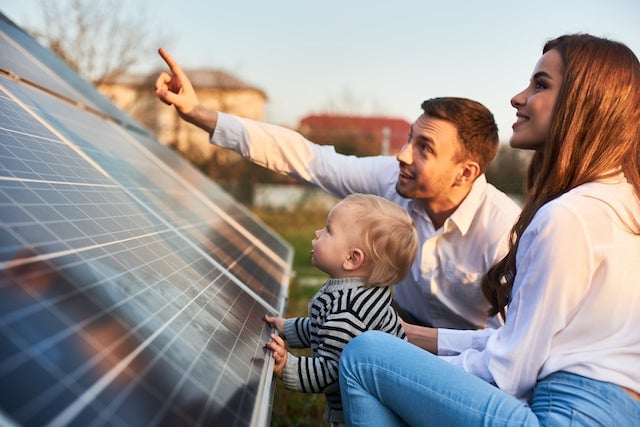
What is solar energy?
When talking about solar power, most people picture the solar panels installed on roofs – this, however, is technically different from what “solar energy” means from a scientific point of view.
What is Photovoltaics?
Put simply, solar energy refers to the energy emitted by the sun, some of which makes its way to Earth. Solar energy can be harvested to produce electricity via a process called photovoltaics.
A photovoltaic (PV) panel, commonly referred to as a solar panel, is made up of hundreds of individual solar cells each made of a semiconductor material: most often silicon.
When sunlight hits the cells in a solar panel, a photovoltaic reaction occurs between the energy of the sun and the (silicon) semiconductor. During this reaction, electricity is generated by the passage of electrons through the cells of the panel. The panel then collects and directs this renewable electricity into the home’s electricity supply, or to a battery for storage.
The photovoltaic process is what we commonly refer to as “solar power,” at least in the context of energy generation in the home. To avoid any confusion and to keep it simple, we will use the common term “solar panels” when referring to photovoltaic panels in this article.
Solar charging
While solar panels on their own can significantly contribute to household cost savings, coupling them with an electric vehicle can multiply their benefits. For one, instead of relying on buying your electricity from the grid, solar panels generate 100% renewable electricity which you can then use to recharge your EV’s battery for free.
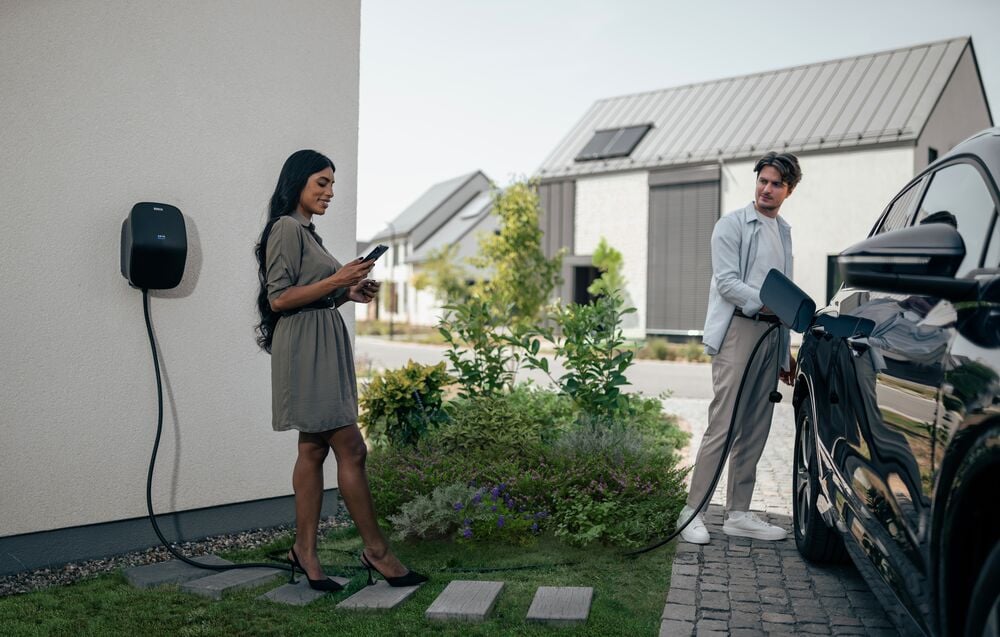
Solar is an uneven and variable power source
There are some arguments, however, over just how reliable home solar charging is for EV batteries. The main issue is that the power generated by solar panels is uneven and highly variable, depending on strength and time of sunlight exposure. As such, it generally can’t be fed directly into an EV’s battery (or any battery for that matter), or the electricity network.
Instead, solar panel installations must typically have an inverter installed to convert the electricity generated from DC to AC. This way it can then be fed into the electricity network at home to power appliances and charge your EV via your installed AC charging station.
Can you fully charge a car with solar?
Truthfully, a standard home solar installation is unlikely to generate enough power in a day to recharge your EV’s battery from 0% to 100%. For those of us who regularly make long trips in our electric vehicles, this may prove a sticking point.
But, do you need to fully replenish your car every day?
However, it is equally true to say that very few homeowners will regularly deplete their EV batteries to such an extent on a daily basis.
In the UK, for example – an infamously cold and dark country – PV panels will produce on average between 1kWh and 9kWhs of electricity per day. An array of 10 panels would therefore generate roughly 10-90kWhs of renewable, free electricity each day. We may infer from this that in lighter, sunnier, warmer countries like the US, those in Central and South America, Australia, countries in mainland Europe, and those in many parts of Asia, this average would be even higher.
How much range can you add with solar?
Even at the lowest projected levels of electricity generation given above, solar charging would still be enough to provide a Standard Range 2023 Tesla Model 3 with about 64km of range, far more than the average daily distance driven in the EU and enough even to cover the average daily commute of Americans (59.5 km (37 miles) a day). If you need a bigger recharge, such as after a long road trip, home solar power can, at the very least, reduce an EV driver's reliance on increasingly expensive grid electricity.
In short, solar EV chargers work by reliably and consistently producing enough renewable electricity to replenish the daily mileage of most EV drivers. Provided you charge by solar during daylight hours (or have a battery backup system for evening and overnight charging), and don't use up the solar power you've generated with other appliances in your home.
Solar chargers
So, can you simply connect your EV charging station to a solar array? Are there specifically designed solar chargers on the market? Or, do you need a smart EV charging station to use solar power to charge your electric car?
The answer to those questions depends on your needs and set-up. But, to be clear, they’re all possible
1. Energy management systems and solar charging
An Energy management system (EMS), also known as a Home energy management system (HEMS), dynamically balances generation/demand between solar systems and other home energy assets.
This could be your car, but could also include your washing machine, dishwasher, oven, etc. By connecting your home EV charger to an energy management system, you can set preferences and optimize the use of your self-generated solar energy via your home energy management system, which will distribute it according to your preferences.
This solution is particularly relevant for homeowners that have more than two smart appliances (like a storage battery, and or a heat pump for example) next to an electric car, a charging station, and a rooftop filled with solar panels.

2. Smart solar and smart charging
Having a smart charging station with a dedicated solar charging feature is a great option to optimize the use of your solar energy. It focuses on optimizing your charging session regarding the solar power you’ve generated. While smart charging features differ, often you will be able to set your solar charging preferences in your charging app. For example, do you only want to use solar power (and not charge when there is no solar available)? Or do you wish to prioritize using the available solar power, and, if needed add electricity from the grid to fill up your car’s battery?

With both smart charging and energy managment system-connection options, you can opt to only charge your EV when your solar panels are generating electricity to ensure that your vehicle is 100% powered by renewables.
The difference between these options comes down to where you want to optimize the use of your solar power and how extensive you want that optimization to be. Is it via your charging station (focused on charging your electric car) or via your home energy management system (focused on all connected smart appliances).
3. Solar charging
If you have solar panels on your roof and a home EV charging station, that can’t connect to an energy management system or a dedicated solar smart charging feature, you can still charge with solar power. However, advanced optimization, settings, or insights won’t be possible.
No matter how you are using solar power to charge your EV, there’s one challenge that solar chargers or EMS can’t solve on their own: storing solar energy to use it at a later time. This is where battery storage systems come in.

How does battery storage work with solar?
A key challenge with solar power, especially when used to charge EVs, is the difference between the average time of electricity production and consumption. Naturally, solar power is mostly generated during the day when the sun shines the brightest. On the contrary, however, most people tend to charge their EVs overnight, or in the evenings once they have returned from work.
A way to overcome this challenge is to store the energy your array generates during the day and use it later when you need it the most. The most popular means of storing solar electricity is by installing storage batteries at home and connecting them to your panels. Using such a setup, you can set your solar panels to charge your batteries during the day, and then recharge your EV overnight using the renewable electricity stored in the batteries.

How much does a solar battery storage system cost?
Buying a storage battery system and connecting it to your home’s electrical supply comes at a certain cost. Not including installation, individual lithium-ion storage batteries can cost between $12,000 and $20,000 – which is, of course, on top of the costs of the solar panel array itself.
Depending on your location, a more affordable alternative to solar battery storage may be to resell the excess electricity produced by your solar array to your utility company or energy provider. This way, whenever you’re not using electricity – for example, if you spend the day at the office – you can feed the power from your solar panels back into the grid and be compensated for it. This process is called ‘net metering.’ However, this is not a possibility everywhere in the world (nor is it expected to stay available everywhere it is a possibility now).
Net metering
While the specifics vary greatly between countries and utility companies, generally net metering allows homeowners to get paid for providing electricity from renewable sources to the grid.
Typically, with net metering a bi-directional electricity meter will measure the number of kilowatt-hours (kWh) delivered to the grid versus the amount of electricity the house draws from the grid. For each surplus kWh fed back to the grid, you earn a pre-agreed credit to be deducted from your overall energy bill.
Net metering is a great way to reduce electricity costs if you cannot use the energy directly when your solar panels generate it. For example, even if you charge your electric car at night without storing the energy in a battery, you can still benefit from a lower electricity bill by selling your solar panels’ production during the day and deducting it from your total electricity consumption.

It’s worth keeping in mind that, although most US states and some EU countries allow net metering, it is not available everywhere in the world (nor will it remain available everywhere it is now).
Bidirectional charging
Beyond storage batteries and net metering, a third option for storing EV solar energy is a promising future technology called bi-directional charging. This technology allows electric vehicles to not only draw power from the grid to charge their batteries but also to send power back to the grid (Vehicle-to-grid) or use it to power your home (Vehicle-to-home).
While the hardware for bidirectional charging is already available in some EVs, the technology itself is not yet widely available.
Last year, we spoke to Jelle van Doornik, product manager at EVBox, in our REVOLUTION podcast and asked him to explain the current status of Bi-directional charging.
Currently, vehicle-to-home and vehicle-to-grid charging remain emerging innovations and have not been deployed on a large scale. Nevertheless, they may yet prove pivotal for the health and load-balancing of our electricity grids by unlocking battery storage at a much larger scale, thus enabling easier access to renewable energy for households at any time of the day or night.
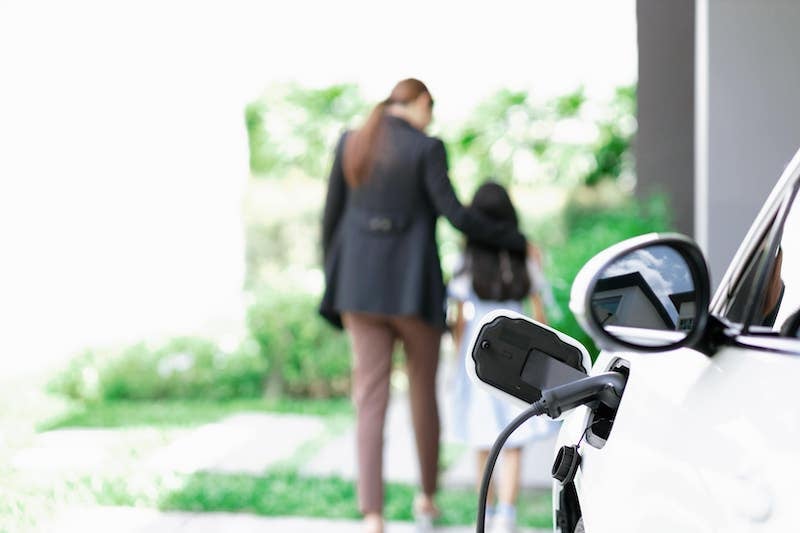
Leveraging government and non-governmental incentives for solar EV charging
As governments around the world accelerate the transition away from fossil fuels, many have begun actively incentivizing homeowners to install renewable energy sources including solar panels. These incentives may come in a variety of forms, including direct subsidies which refund a percentage of the solar installation costs, more attractive energy tariffs through net metering schemes, tax rebates, or lower rates on your energy bills.
The UK, for example, offered a guaranteed feed-in tariff for homeowners installing solar panels, ensuring they would be able to sell the energy their panels produced to their utility company at an attractive price. The Netherlands also allows its residents to deliver solar-produced energy back to the grid at a full tariff, while many US states offer subsidies and tax credits on top of a federal tax rebate.
In some countries, non-governmental organizations with green energy goals may also offer a variety of grants and incentives to homeowners keen to charge their EVs with residential solar.
The incentives available for domestic EV solar charging plans vary greatly depending on your country, region, and local authority, but generally, they can considerably reduce the cost of installing solar panels at home. Keep in mind that on top of incentives for solar power, many countries also offer various benefits for installing an EV charging station, further cutting costs if you’re using solar energy to charge your EV.
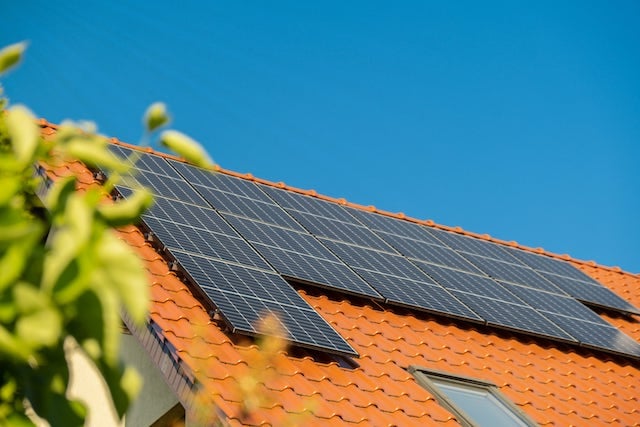
When it comes to EV charging, are solar panels worth it?
As with any investment, there are both pros and cons to charging your EV with household solar power. We've listed both the arguments for and against EV home solar charging so that you make a more informed and confident decision.
Pros of solar and charging
- Lower electricity cost: Solar-generated electricity is entirely free, meaning it won't add to your monthly utility bills. By strategically using solar power during peak hours and switching to grid electricity during off-peak times with lower tariffs, you can further reduce your overall electricity expenses.
- Charging for free: Depending on your daily mileage, you may find that you can often charge your EV for free thanks to your home solar system.
- Accessing more financial benefits: Potentially participate in net metering schemes, and earn tax credits or cash rewards by feeding surplus solar power back into the grid.
- Reducing your carbon footprint: Decrease your environmental impact by generating clean, renewable solar energy to charge your car.
- Becoming energy independent: Create an independent, off-grid energy solution for your household.
Cons of solar and charging
- Initial high investment costs: The initial investment required to install solar panels at home can be high. (However, there are plenty of government schemes available globally that help make solar affordable)
- Weather dependency: Solar panel efficiency relies on weather and sunlight conditions, impacting electricity generation.
- Need for battery storage: If your EV spends daylight hours away from home, investing in battery storage becomes essential to continue utilizing solar power for recharging.
- Energy generation limits: Typically, a standard household solar array might not produce enough power in a single day to fully recharge an EV battery from 0% to 100%.
- Ownership requirement: To install solar panels, you need ownership of your roof or a sizable and accessible land plot, which might not be feasible for urban residents.
- Consider moving challenges: Keep in mind that moving your EV-charging setup when you change residences can be a logistical challenge.
What is the future of solar energy?
As the world transitions away from carbon-intensive energy sources, renewables such as solar will play an increasingly crucial part in our electrical supply.
Solar power is an attractive way for households to reduce their energy costs, gain independence from the grid, and guarantee sustainably generated electricity with which they can recharge their EVs daily
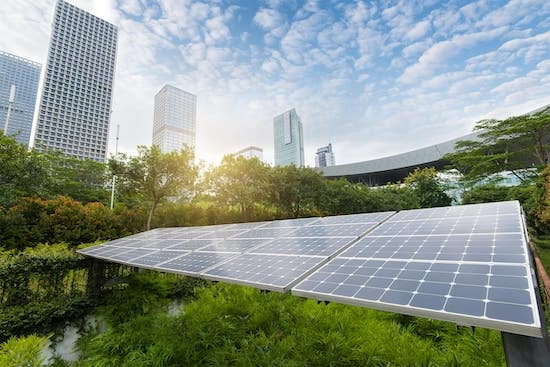
Pairing solar panels with EV charging stations allows you to recharge with renewable energy generated right there on your own roof.
Charging EVs with solar power at home is more than possible. It is happening right now, all around the world, and can be highly beneficial to the EV driver from a financial, environmental, and energy efficiency perspective.
Related articles

Smart Charging for Solar EV Systems: What is possible today?
There are a variety of smart solutions available, capable of optimizing your solar EV charging system in different...

Can solar EV charging save you money?
Charging your EV using household solar panels can indeed save you money on your utility bills. How much money solar EV...
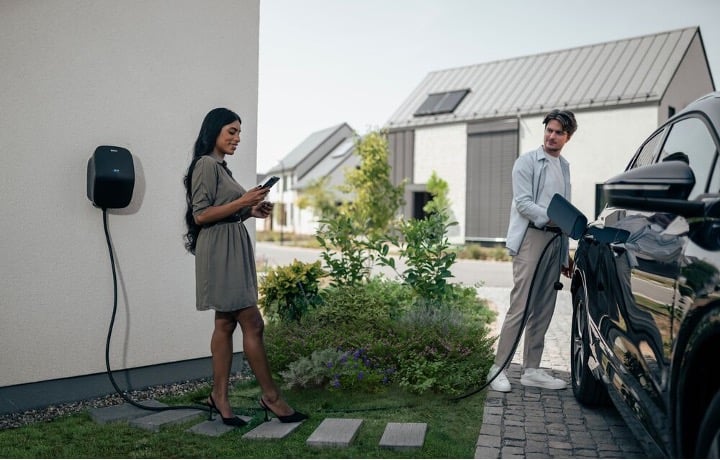
How to optimize your solar set-up for charging electric cars at home
There are several ways EV drivers can optimize a homegrown solar system to ensure their EV recharging needs are met....

